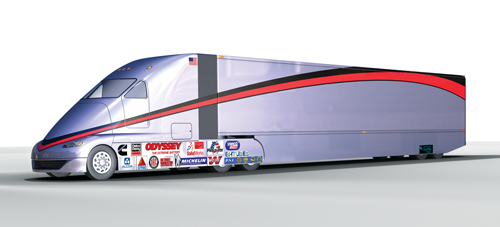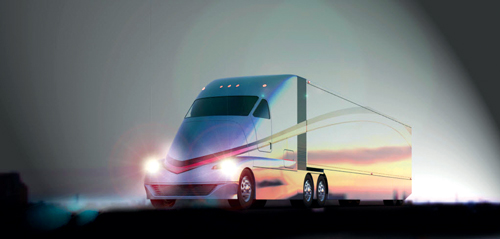December 1, 2011
By Kenneth Wong
Underneath its fiberglass and metallic skin, the SuperTruck, as it’s been proudly dubbed by its co-creators Bob Sliwa (AirFlow Truck Co.) and Jeremy Singley (Jeremy Singley Industrial Design), is still a class 8 tractor trailer rig. But it looks more like a bullet train, poised to shoot down the highway at unprecedented speed.
Sliwa and Singley hope that, unencumbered by a typical truck’s square front, the SuperTruck’s elegant nose will slice through the air more efficiently, promising to burn 25% less fuel than a standard rig. The aerodynamically improved vehicle “could potentially save the trucking industry over 7.5 billion gallons of fuel and 21 million tons of toxic exhaust emissions annually,” according to its makers.

Based on Bob Sliwa’s idea, Jeremy Singley turned the SuperTruck into a
digital model in SolidWorks.
Meeting of the Minds
When Sliwa was a child, he satisfied his mechanical curiosity by taking apart his toys to study their inner workings. Later, as a teenager and auto mechanic, he discovered the thrill of drag racing. Eventually, his passion shifted to trucking and truck design.
Using lessons from his racing days, Sliwa wanted to “substantially lower the cost-per-mile operating cost for fleet operators and owners of rigs,” as he put it. Through experimentation and real-world freight runs, he felt he could push a truck’s fuel efficiency to 10 miles per gallon. But to prototype, test and verify his ideas digitally, Sliwa turned to Singley, an industrial designer and a SolidWorks user.
“Sliwa’s ultimate aim is to produce a kit so truckers can do what he’s doing: rip off the body of their truck, then replace it with a more aerodynamic body,” Singley explains. Sliwa hired Singley to help design the kit—not the entire vehicle, but the portion that will attach to the front of the truck. The working relationship was reinforced by Singley and Sliwa’s shared tendencies to tinker with vehicles.
“My wife and I, we built our first car from junkers,” Singley admits.
Singley encountered CAD for the first time in a design communication course at the Vermont Technical College, under the tutelage of a former Black & Decker home appliance designer.
“In my ]furniture] shop, I used to just grab a piece of wood and start working,” he recalls, noting that with CAD, he can do the same—all while breathing in less sawdust. “I just like the way parametric CAD systems work.”
Though he was trained on Autodesk Inventor in school, Singley eventually switched to SolidWorks after graduation.
Skinning a Truck
Sliwa’s original idea for SuperTruck is to produce a kit that truckers can use to make their vehicles more aerodynamic. What usually hampers a truck’s efficiency, as it turns out, is the classic shape of its head. Comprised of blocky geometry and flat surfaces, it pushes against the wind to create more resistance than necessary. With Sliwa’s kit, truckers would be able to replace the original truck’s front portion with a smoother nose.
One of the major hurdles, Singley reveals, was the shape of the SuperTruck’s hood, constructed with spline curves. “To loft a surface from a square to a parabola, especially with a square that’s perpendicular to the parabola—that’s something parametric software hates to do,” he says. “You have to trick the software into doing it for you. I did it in sections, connecting up the pieces with boundary surfaces with curvature control.”
SolidWorks comes with advanced surfacing tools, but, like most parametric mechanical CAD programs, it may not offer the ease and freedom found in non-uniform rational basis spline (NURBS) surfacing programs, such as Rhino.

“I would very much look forward to such capabilities ]freeform surfacing], and I think SolidWorks may be overlooking the fact that 21st-century engineering will find uses for morphable surfaces in fluid dynamics, optics, acoustics, medical devices and a slew of other fields,” says Singley. “At the very least, it’s handy when engineers and designers need to refit enclosures as internal parts are revised. I designed a health product recently, where I was able to quickly adjust a curvaceous enclosure to fit by tweaking the surface with SolidWorks’ freeform feature. That’s a handy feature for minor adjustments like that, but it’s pretty clunky otherwise. Softer splines would be nice, too. That’s really my only criticism. Even with that limitation, I feel SolidWorks is the best software for the price.”
Next up: The Alpha Concept Vehicle
Sliwa relied on his experience and intuition to dictate the specs for the digital model of the SuperTruck, which Singley translated into a SolidWorks CAD model. Because the SuperTruck kit was designed to fit onto a conventional truck’s frame, the kit’s parameters had to conform to truck manufacturers’ specifications.
“There was a limit to what we could do. We can’t change where the windshield is, where the driver sits, and where the tires are,” Singley points out.
Once the digital SuperTruck model reached the prototype stage, Singley grew more ambitious and decided to design the ultimate truck of the future, dubbed the 2015 Alpha Concept Vehicle. He started the project by asking, “If we were able to build a new truck, using new tooling, from the ground up, how far could we go with aerodynamic streamlining?”
Singley asked SolidWorks whether the company would be willing to sponsor the project by offering a courtesy seat of Cosmos FlowWorks. (After SolidWorks’ acquisition of CosmosWorks, SolidWorks rebranded FlowWorks as SolidWorks Flow Simulation.) The company agreed to his proposal and gave Singley the opportunity to look at the truck’s aerodynamics.
When Singley ran airflow analysis on the SuperTruck design to see what improvements could be made, he was in for a surprise.
“Bob’s got the knack,” says Singly. It turned out only slight tweaks were needed to optimize the SuperTruck kit’s shapes. With a similar method, he was also able to identify the best possible shapes for his subsequent project, the Alpha Concept Vehicle.
The sponsorship from SolidWorks included not only a seat of the software, but also a training class. Singley drove to SolidWorks’ Concord, MA, headquarters, and spent two days learning the computational fluid dynamics (CFD) program.
“It was a breeze,” he says. “It was so intuitiveIt was just very easy to pick up. There are certainly some principles involved in aerodynamics, but you can get those off the web anyway. What it really comes down to is just trying stuff.”
Though digital experimentation, Singley discovered that “sometimes, adding something to the hood can have effects 20 ft. behind the truck. The analysis software offers so many ways to look at that—surface plots, pressure probes, etc.”
Dealing with Vacuums
The biggest drag that hampered a truck’s agility, Singley discovered, was the square-shape back end. “There’s a huge vacuum back there,” he notes, “and the effect stretches many hundreds of feet behind the truck.”
Building on tricks he’d learned from Sliwa, Singley figured out that he could reduce turbulence by introducing a more curvaceous boat-tail and redesigning the skirt, which also provides surface area for sponsorship logos to appear. However, he’s still grappling with the air trapped in the underside of the truck. It may be a problem many truck designers are willing to accept as inevitable, but, Singley admits, “Bob and I are both perfectionists, so we keep looking at it and asking, ‘Well, what else can we do?’”
In his photo-realistic rendering of the SuperTruck presented to potential sponsors, Singley added the current sponsors’ logos on the skirt of the model as decals (2D image projected on 3D surface). If AirFlow Truck receives more sponsors, Singley envisions having trouble fitting more logos onto the skirt.
Earlier this year, a 3D-printed fused deposition model of the Alpha Concept Vehicle made its debut under a glass case at SolidWorks World 2011. Meanwhile, with about 20 corporate sponsors fueling the project, the SuperTruck now moves from digital design to physical prototype. Currently, the kit includes the hood, bumper, skirts and an extensive package of mechanical fuel-saving improvements. If all goes well, the beta version of Sliwa and Singley’s SuperTruck will literally hit the road in October.
Kenneth Wong is DE’s senitor editor and writes DE’s Virtual Desktop blog at deskeng.com/virtual_desktop. You can follow him on Twitter at KennethwongSF, or email him via [email protected].
MORE INFO
Subscribe to our FREE magazine, FREE email newsletters or both!
About the Author
Kenneth Wong is Digital Engineering’s resident blogger and senior editor. Email him at [email protected] or share your thoughts on this article at digitaleng.news/facebook.
Follow DE





